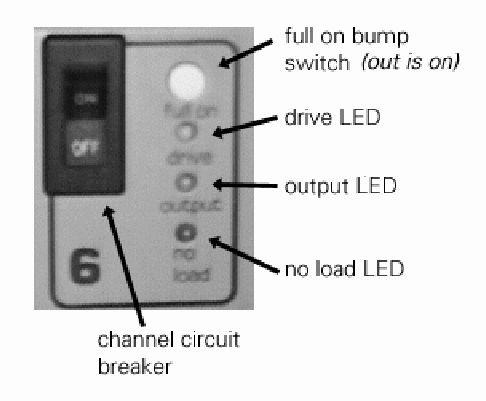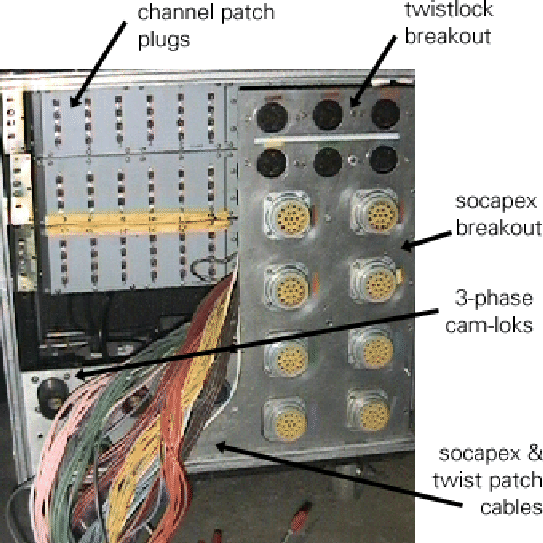
|

|
WPI Technical Theatre Handbook: Dimmer History | 
|
|||
|
Next: Cables and Connectors Up: Dimmers Previous: Dimmers Contents Index Dimmer HistoryThe earliest electrical lighting used in theatres was not dimmable; it was either on or off. Precise control of light levels is a recent addition to the theatre. The technology for dimming instruments has improved markedly since dimming schemes were invented in the early part of the 20th century. Bulky, inefficient methods for dimming have been replaced with small, efficient solid state circuitry. It is not uncommon to find small rack-mount units that contain eight or more dimmable channels such as those shown in in figure 5.14. Often several of these units are mounted in a permanent installation or portable roadcase, along with power connectors, lighting instrument connectors, and a hard-patch area. Hard patching is the process of connecting individual lighting instruments to dimmer channels. Each dimmer channel allows for independent control of whatever is connected to it, be it one or many instruments. The means for hard patching vary from theatre to theatre, but the concept is the same.
Dimmer units that can run multiple channels of lighting in a single box generally have a front panel with some controls and indicators for each channel. It is quite common to find a circuit breaker, a bump switch, and a variety of LED indicators for each channel. The circuit breaker is a means for automatic shutdown of the circuit should it be overloaded. The bump switch allows the individual channel to be turned on at the dimmer, which is convenient for testing and hard patching. Common types of indicators are those that show whether a channel is active and whether it has anything connected to it. Figure 5.15 shows a closeup of the controls of an typical individual dimmer channel.
Many different schemes are used for hard patching dimmers. At WPI, the dimmers used for most productions are portable, so a wall-mounted hard-patch area is not present, as in some theatres. Instead, each rack of dimmers has a panel on the rear with special breakouts for lighting cable connectors. Individual twist-lock and multiple conductor Socapex connectors are available for breakouts. These connectors are discussed in more detail in section 5.6. Lighting instruments are connected to the breakouts, and the individual wires of the breakouts are then connected to the channel outputs on the rear of the dimmers. When hard patching, it is important to pay close attention to the power requirements of the lighting instruments and the power capabilities of the individual dimmer channels. While it is often desirable to put several instruments on a single dimmer channel, some instruments use too much power to make this possible. The racks of Leprecon dimmers that are used at WPI can provide 2400 watts per channel while the NSI digital dimmers provide 1200 watts per channel.
Some dimmers, such as the NSI digital dimmers shown in figure 5.17, have no provisions for hard patching, per se. Some models have edison style connectors on the rear, for direct connection of common consumer-style lighting equipment. Others have multi-conductor Socapex connectors, wired such that one dimmer channel powers a single channel of the Socapex cable.
Next: Cables and Connectors Up: Dimmers Previous: Dimmers Contents Index Steve Richardson 2000-07-06 Use of information in this document implies understanding and agreement with the copyright and terms of use. Specifically, no warranty is expressed or implied regarding the accuracy of the information contained within. YOU USE THIS INFORMATION AT YOUR OWN RISK. All trademarks are property of their respective owners. You must obtain permission from the author before using the contents of The Handbook for anything other than private use. |
Table of Contents
| ||||



